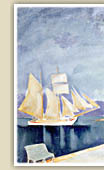
but at the same time the decision of more and more Greek artists to study in Paris encouraged
the introduction of French artistic teachings into Greece.
Towards the end of the nineteenth century Impressionism had already reached Greece, if
with a certain delay. It was the first artistic movement that challenged the status quo and attempted to break the shackles imposed by Academicism.
Konstantinos Parthenis, Konstantinos Maleas and
Yorgos Bouzianis, who first appeared on the scene around 1909, were the prominent artists of their day. Their work was imbued with the
teachings and principles of Impressionism, which they pursued in the following period.
Amont the important artists who continued their work in this period (some of whom were beginning their artistic careers), were Georgios Iakovidis,
Symeon Savvidis, Pavlos Mathiopoulos, Thalia Flora-Karavia, Sofia
Laskaridou, Nikolaos Othonaios, Nikolaos Dragoumis, Georgios Hatzopoulos,
Nikolaos Lytras, Stellios Miliadis, Michail Oikonomou and Theofrastos Triantafyllidis.
Pavlos Mathiopoulos was the painter who expressed in his painting the spirit of the
belle epoque. He had shaped the taste
of the bourgeois class for the belle epoque, and now was the vehicle of Art Nouveau.
In 1917 the 'Art Group' was formed. This was made up chiefly of painters of the last generation of the nineteenth
century, equivalent to similar European artistic movements and had the goal
of disengaging art from established forms and academic features. It split up
two years later, but its very existence was indicative of the transitional period that Greek painting
was going through.
|
 |
